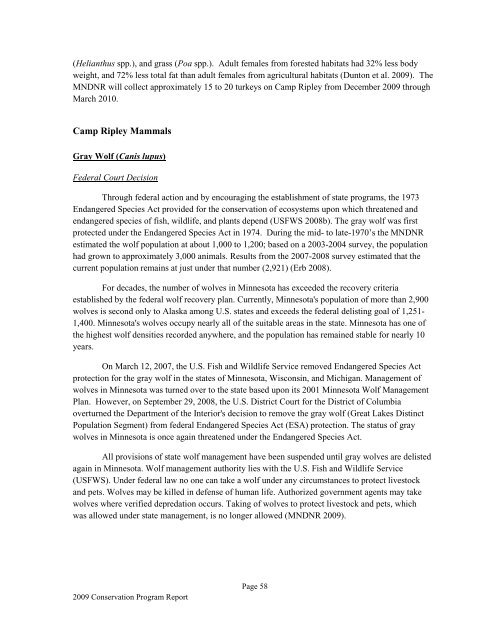camp ripley and arden hills minnesota army national guard training ...
camp ripley and arden hills minnesota army national guard training ...
camp ripley and arden hills minnesota army national guard training ...
Create successful ePaper yourself
Turn your PDF publications into a flip-book with our unique Google optimized e-Paper software.
(Helianthus spp.), <strong>and</strong> grass (Poa spp.). Adult females from forested habitats had 32% less body<br />
weight, <strong>and</strong> 72% less total fat than adult females from agricultural habitats (Dunton et al. 2009). The<br />
MNDNR will collect approximately 15 to 20 turkeys on Camp Ripley from December 2009 through<br />
March 2010.<br />
Camp Ripley Mammals<br />
Gray Wolf (Canis lupus)<br />
Federal Court Decision<br />
Through federal action <strong>and</strong> by encouraging the establishment of state programs, the 1973<br />
Endangered Species Act provided for the conservation of ecosystems upon which threatened <strong>and</strong><br />
endangered species of fish, wildlife, <strong>and</strong> plants depend (USFWS 2008b). The gray wolf was first<br />
protected under the Endangered Species Act in 1974. During the mid- to late-1970‟s the MNDNR<br />
estimated the wolf population at about 1,000 to 1,200; based on a 2003-2004 survey, the population<br />
had grown to approximately 3,000 animals. Results from the 2007-2008 survey estimated that the<br />
current population remains at just under that number (2,921) (Erb 2008).<br />
For decades, the number of wolves in Minnesota has exceeded the recovery criteria<br />
established by the federal wolf recovery plan. Currently, Minnesota's population of more than 2,900<br />
wolves is second only to Alaska among U.S. states <strong>and</strong> exceeds the federal delisting goal of 1,251-<br />
1,400. Minnesota's wolves occupy nearly all of the suitable areas in the state. Minnesota has one of<br />
the highest wolf densities recorded anywhere, <strong>and</strong> the population has remained stable for nearly 10<br />
years.<br />
On March 12, 2007, the U.S. Fish <strong>and</strong> Wildlife Service removed Endangered Species Act<br />
protection for the gray wolf in the states of Minnesota, Wisconsin, <strong>and</strong> Michigan. Management of<br />
wolves in Minnesota was turned over to the state based upon its 2001 Minnesota Wolf Management<br />
Plan. However, on September 29, 2008, the U.S. District Court for the District of Columbia<br />
overturned the Department of the Interior's decision to remove the gray wolf (Great Lakes Distinct<br />
Population Segment) from federal Endangered Species Act (ESA) protection. The status of gray<br />
wolves in Minnesota is once again threatened under the Endangered Species Act.<br />
All provisions of state wolf management have been suspended until gray wolves are delisted<br />
again in Minnesota. Wolf management authority lies with the U.S. Fish <strong>and</strong> Wildlife Service<br />
(USFWS). Under federal law no one can take a wolf under any circumstances to protect livestock<br />
<strong>and</strong> pets. Wolves may be killed in defense of human life. Authorized government agents may take<br />
wolves where verified depredation occurs. Taking of wolves to protect livestock <strong>and</strong> pets, which<br />
was allowed under state management, is no longer allowed (MNDNR 2009).<br />
2009 Conservation Program Report<br />
Page 58
















